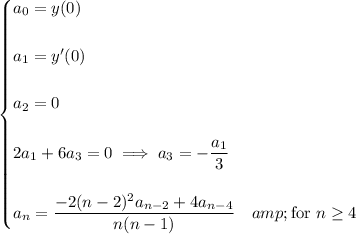We're looking for a solution of the form

with derivatives


Substituting these into the ODE gives

Shifting indices to get each term in the summand to start at the same power of
 and pulling the first few terms of the resulting shifted series as needed gives
and pulling the first few terms of the resulting shifted series as needed gives

Then the coefficients in the series solution are given according to the recurrence

Given the complexity of this recursive definition, it's unlikely that you'll be able to find an exact solution to this recurrence. (You're welcome to try. I've learned this the hard way on scratch paper.) So instead of trying to do that, you can compute the first few coefficients to find an approximate solution. I got, assuming initial values of
 , a degree-8 approximation of
, a degree-8 approximation of

Attached are plots of the exact (blue) and series (orange) solutions with increasing degree (3, 4, 5, and 65) and the aforementioned initial values to demonstrate that the series solution converges to the exact one (over whichever interval the series converges, that is).